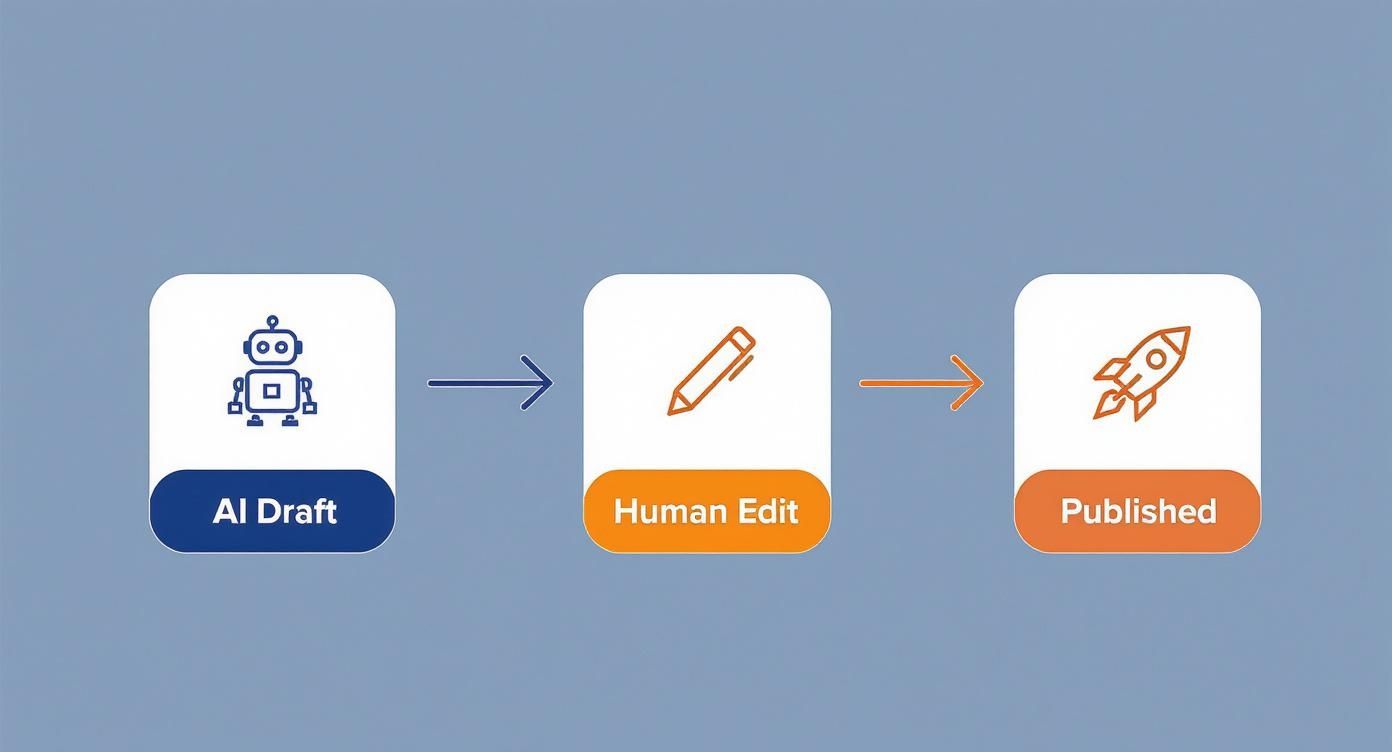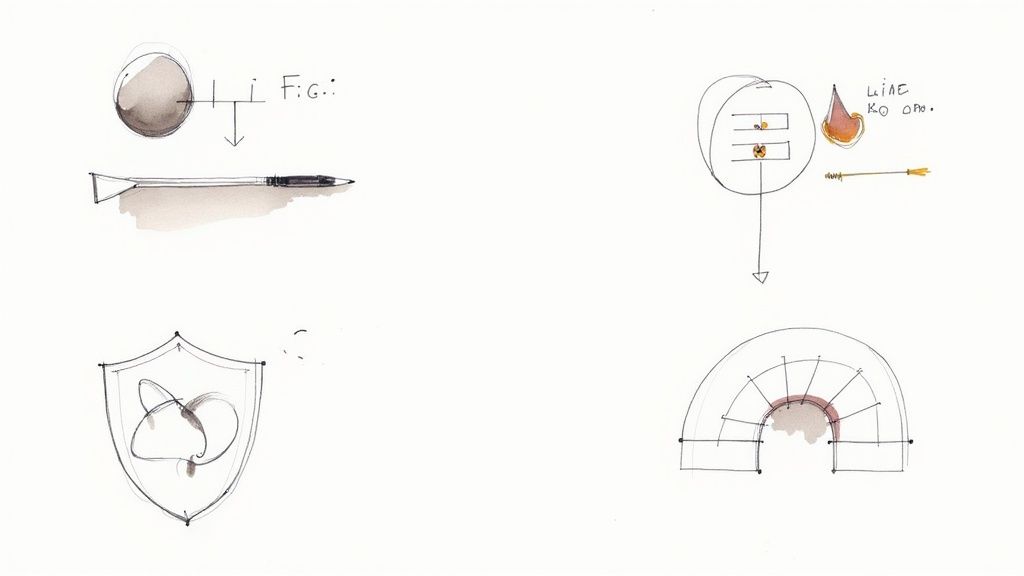
AI-generated text is a fantastic starting point, but making it truly connect with people requires a human touch. This isn't just about catching a few typos; it's about weaving in your unique perspective and experience to transform a robotic draft into something genuinely compelling.
Why Raw AI Text Needs a Human Touch
AI writing tools are incredibly useful for getting ideas on the page and creating a first draft in minutes. But if you stop there, your content will likely sound generic, repetitive, and completely forgettable.
Think of AI as providing the blueprint for a house. The structure is there, but it’s missing the paint, furniture, and personal touches that make it feel like a home. You, the writer, are the one who adds the character and personality.
AI models learn from a massive ocean of existing online content, making them great at replicating patterns but poor at creating original ideas. This is why you must rewrite AI generated text: to add the authentic voice and insights that machines can't replicate.
The Rise of AI in Content Creation
It’s no secret that AI is now a core part of many content workflows. New data shows that 71.7% of content marketers use AI for outlining, 68% for brainstorming, and 57.4% for writing first drafts. These figures from Siege Media confirm AI is a go-to assistant for creators.
However, this also highlights the massive need for skilled writers and editors to handle the final, critical step: making the content feel real. At PureWrite, we believe your goal isn't to avoid AI but to use it as a powerful starting point.
"The real value comes from the creativity, critical thinking, and unique perspective that only a human can provide."
This is why learning to rewrite AI-generated text is such a vital skill for any content creator, student, or professional. You're not just editing; you're transforming a logical but lifeless piece of text into something that reflects your authentic voice.
Raw AI Output vs Human-Edited Content
Let's look at a side-by-side comparison to see exactly what we're talking about. The difference is often night and day.
| Characteristic | Typical Raw AI Output | Human-Rewritten Result |
|---|---|---|
| Tone & Voice | Formal, generic, and often overly academic or promotional. | Authentic, conversational, and aligned with a specific brand voice. |
| Sentence Structure | Repetitive sentence patterns (e.g., Subject-Verb-Object). | Varied sentence lengths and structures for better rhythm and flow. |
| Originality | Rehashes common knowledge without unique insights. | Includes personal anecdotes, original analysis, and fresh perspectives. |
| Emotional Connection | Lacks emotional depth; reads like a factual report. | Evokes emotion, uses storytelling, and builds empathy with the reader. |
| Credibility | Often makes vague claims or uses filler language. | Cites specific data, shares real-world examples, and demonstrates genuine expertise. |
As you can see, the human-rewritten version isn't just "better"—it's more trustworthy, memorable, and effective at achieving its goal.
The Problem with Robotic Content
AI-generated content often falls short in two key areas: authenticity and expertise. Readers can usually tell when something was written without a real human behind it, which can damage your credibility.
This is especially true for students and professionals. With AI detection tools becoming more sophisticated, submitting raw AI work can have serious consequences. For instance, if you're a student, our guide on whether Turnitin can detect AI explains the risks involved.
Here at PureWrite, our philosophy is simple: AI should be your assistant, not your author. Taking the time to refine what an AI gives you ensures the final product is truly yours.
Ready to transform your AI drafts into authentic, engaging content? Try PureWrite to see how easy it is to add that essential human touch.
A Practical Workflow for Turning AI Text into Great Content
Knowing why you need to edit AI content is one thing, but knowing how to do it efficiently is what really makes a difference. You need a reliable process to take a robotic first draft and transform it into something engaging.
We recommend a workflow that splits the task into two clear phases: big-picture "macro" edits and sentence-level "micro" edits. This approach prevents you from getting bogged down in comma placement when the entire article structure needs work.
This visual gives you a quick snapshot of the journey from a raw AI draft to a polished, published piece. The magic happens in that middle step.

That human edit is the bridge between what the machine creates and what your audience actually wants to read.
Start with the Big Picture: Macro Edits
Before you touch a single word, you have to zoom out and look at the draft from a high level. This is the macro stage, and skipping it is a common mistake that can lead to a beautifully written article that completely misses the mark.
First, and we can't stress this enough, is fact-checking and verification. AI models are notorious for "hallucinating"—making things up with incredible confidence. You must scrutinize every statistic, claim, and date, as your credibility is on the line.
Next, turn your attention to the structure and flow. Does the intro hook the reader? Do the sections transition logically? This is where you might reorder entire sections or delete fluffy paragraphs to build a tighter narrative.
Our Advice: The macro edit is all about building a solid foundation. Make sure the content is accurate, well-organized, and serves a purpose before you start polishing sentences.
Finally, check for strategic alignment. Does this article sound like your brand and speak to your audience's problems? This is where your human expertise adds the crucial context that a machine can’t.
Zoom In on the Details: Micro Edits
Once the article's skeleton is solid, it's time to add the personality. The micro-editing phase is where you breathe life into the text, polishing the prose until it sounds like a real person wrote it—specifically, you.
Here’s what you should focus on during the micro pass:
- Inject Your Voice: Hunt down generic AI phrases like "It is imperative to consider..." and replace them with direct, conversational language. Use your own humor, terminology, and perspective.
- Vary Your Sentences: AI often produces sentences with the same length and structure. Mix it up by following a long, descriptive sentence with a short, punchy one for a more dynamic reading experience.
- Add Real Stories: This is your secret weapon. An AI can't share personal anecdotes or client success stories. These details build trust and connection in a way that pure data never can.
- Switch to Active Voice: AI drafts are often filled with passive voice ("The report was written by the team"). Flip it to the active voice ("Our team wrote the report") for more direct and confident writing.
This two-phase workflow provides a repeatable system to rewrite AI generated text. When you get to the micro-editing stage, a good tool can be a lifesaver. We built PureWrite to streamline this exact process, helping you amplify your voice and rewrite content faster.
Learning to Spot and Fix AI's Bad Habits
AI models have predictable writing habits. Once you learn what they are, you'll start seeing them everywhere. Think of this as your field guide to identifying robotic tells and transforming a clunky draft into something that connects with readers.

Before you can rewrite AI text effectively, you have to know what you’re looking for. The good news is these quirks are surprisingly obvious once you know what to spot.
The Stuffy Tone and Overuse of Transition Words
One of the biggest giveaways of raw AI content is its obsession with formal transition words. You'll see words like "Furthermore," "Moreover," "In addition," and "In conclusion" peppered throughout the text, making it read like a stuffy academic paper.
While these words aren't inherently bad, AI overuses them. In most cases, you can simply delete them, and the sentences will flow much more naturally.
A helpful rule of thumb: If a sentence works perfectly fine after you remove the transition word at the beginning, it probably didn't need to be there.
Here is a quick before-and-after example for a marketing blog post:
- Before (AI Draft): "Moreover, it is imperative for businesses to consider their target audience. Furthermore, creating a detailed customer persona is a beneficial exercise."
- After (Human Edit): "You need to know your target audience inside and out. A great way to start is by creating a detailed customer persona."
See the difference? The edited version is far more direct and readable. This is one of the easiest ways to start humanizing AI content.
Repetitive Sentence Structures
AI models love patterns, which often results in sentences that follow the same "Subject-Verb-Object" structure. This creates a monotonous rhythm that can bore your reader.
The fix is to consciously vary your sentence structure. Combine short, punchy statements with longer, more descriptive ones. If you need a refresher on sentence variety, check out this guide on basic grammar rules.
It's also worth noting that while AI rewriters are fantastic for shorter documents, they can sometimes struggle with longer or highly specialized content. They perform best on passages from a paragraph to a few pages.
Your Robotic Writing Checklist
To make this process easier, we've put together a practical checklist. Before you publish that AI-generated draft, run it through these questions.
- Is the tone too formal or robotic? Swap stiff, academic language for more conversational words.
- Are there too many transition words? Go on a "moreover" hunt and delete without mercy.
- Do several sentences start the same way? Rework them to create better rhythm and flow.
- Is the content full of vague claims? Back them up with specific data, real-world examples, or a personal anecdote to build trust.
Running through this checklist will help you systematically clean up your draft. And when you're ready to make this process even faster, give PureWrite a try. Our tool automatically flags these common issues and suggests more human-sounding alternatives.
Tools and Techniques for Better AI Rewrites
Let's be honest: rewriting AI content can feel like a chore. But with the right tools, you can transform that clunky draft into something that truly connects with your audience.
This is exactly why we created PureWrite. We wanted to build something that goes far beyond just swapping out a few words. It's designed to be your writing partner, helping you zero in on the subtleties of style, tone, and flow that make writing sound authentic.

This kind of careful editing is more important than ever. The generative AI market has exploded, with a staggering 92% of Fortune 500 companies already using AI. For a deeper dive, you can explore the latest generative AI statistics.
Building Your Content Humanization Stack
A great rewrite isn't the result of a single tool; it comes from a smart, layered approach. Think of it as building a "stack" where each tool plays a specific role.
- Humanizing Platforms: This is your starting quarterback. A powerful humanizer like PureWrite does the heavy lifting—restructuring sentences, upgrading word choices, and ensuring the tone feels right.
- Readability Checkers: Once you have a good draft, run it through something like the Hemingway Editor. It’s brilliant at catching long, winding sentences that make your writing feel dense.
- Plagiarism and AI Detectors: This is your quality control step. Before you publish, you need to be sure your work is original and doesn't still carry the robotic fingerprint of its AI origins.
- Fact-Checking Resources: This one is non-negotiable and requires human oversight. AI is notorious for "hallucinating" facts, so always double-check any stats or claims with reliable sources.
Key Takeaway: The best workflow is a blend of technology and human judgment. You start with a powerful humanizer, then refine with tools for readability, originality, and fact-checking.
This combination of smart tools and critical thinking is what separates good content from great content. To go even further, check out our guide on the best content optimization tools.
Ready to see how a purpose-built tool can change your process? Try PureWrite now and feel the difference it makes in creating authentic content.
Writing Ethically with AI
Bringing AI into your writing workflow isn't just about speed; it adds a crucial layer of responsibility. When you rewrite AI generated text, you are claiming ownership of the final product.
At PureWrite, we champion an "AI-assisted, human-authored" model. The AI is your assistant, but you are the author. The final piece must be a genuine reflection of your expertise, voice, and integrity.
Think of it like a partnership where you always have the final say. It’s on you to make sure every claim is solid and every source is credible. This ethical check is what separates thoughtful content from robotic noise.
Upholding Transparency and Trust
People read your work because they trust you to be accurate and honest. If you just copy and paste from an AI draft, you're breaking that trust.
It's a known issue that AI models can "hallucinate"—they sometimes invent information and present it with complete confidence. Your most important job is to be a relentless fact-checker. Every statistic and statement needs to be verified before your audience sees it.
Beyond that, you have to ensure the work is truly your own. AI models are trained on data from across the internet, so accidental plagiarism is a real risk. Always run a check to protect your reputation.
Our Philosophy: Real authenticity isn't about hiding that you used AI. It’s about adding so much of your own human value—your unique stories, insights, and expertise—that the AI's initial contribution becomes a footnote. The goal is to create something that is unmistakably yours.
Preventing Misinformation and Ensuring Originality
As a writer, you have a duty to stop the spread of misinformation. Before you hit publish, ask yourself: Have I checked these claims against primary sources? Is this content clarifying the topic or adding to the confusion?
This critical thinking is something only a human can bring to the table.
Your originality is just as important. AI detectors are popping up everywhere, but your goal shouldn't be to fool software. It should be to create content so insightful and unique that no one questions its origin. Our guide on how to bypass AI detection shows how human-led rewriting naturally produces undetectable content.
In the end, using AI ethically boils down to one word: accountability. When you put your name on something, you are vouching for its quality. Try PureWrite to make sure your final draft lives up to that promise.
Questions We Hear All the Time About Rewriting AI Text
As you start using AI in your writing process, you're bound to have questions. Here are some of the most common ones we hear, with straightforward, practical advice.
So, Can Google Actually Detect AI Content?
This is the #1 question people ask. The short answer is: they're not looking for "AI content," they're looking for bad content.
Google's main job is to show people helpful, reliable information. The problem is that a lot of unedited AI output feels spammy and unhelpful—the very things Google has been fighting for years.
Your goal isn't to trick a detector. It's to add your own expertise and unique perspective. If you focus on making the content valuable for a human reader, you’ll be in line with what Google wants to see.
How Much of the AI Draft Do I Really Need to Change?
Forget about percentages. The real question is, have you made it yours?
A great rewrite breathes your personality and knowledge into the text. It adds specific examples, stories, and insights that an AI simply can’t invent. For example, a student might add a personal reflection to an essay, while a marketer could include a case study from a recent campaign.
Here’s a simple test: Does the final version sound like something you would actually say? Does it offer a unique perspective? If the answer is yes, you've done the work.
What's the Quickest Way to Get This Done?
The fastest way to humanize AI text is to stop editing line-by-line from the start. You need a better workflow.
First, start with the big picture—the "macro" edit. Fix the overall structure, check the flow, and ensure the core message is strong. Don't get bogged down in word choices yet.
Next, bring in a specialized tool like PureWrite. It can do the heavy lifting on a sentence level, helping you fix that robotic tone and smooth out awkward phrasing.
Finally, you do a personal pass to inject your own voice, add a personal story, or include a unique tip. This layered approach saves time and produces a much better result.
If you want to dig deeper, our guide on using an AI text humanizer has more practical strategies.
Ready to turn those clunky AI drafts into content you’re proud of? PureWrite is built to help you refine, polish, and find your voice—fast. Try PureWrite for free today and feel the difference it makes.